Golden Eye Diamond
Open FREE Unlimited Store Join Our Newsletter
Lareef A. Samad B.Sc (Hons)
Origin of Name
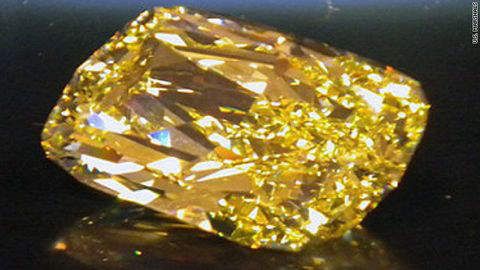
The Golden Eye Diamond
The name "Golden Eye" seems to reflect not only the fancy intense yellow color of the diamond, which in common parlance is referred to as a golden color, but also the fire and brilliance, associated with the rectangular brilliant cut of the diamond, believed to be the largest diamond of this color and cut in the world.
Characteristics of the Diamond
The 4Cs of the Diamond
The Golden Eye Diamond is a 43.51-carat, flawless, fancy intense yellow, rectangular brilliant cut diamond. Though clarity may not be relevant for intense colored diamonds, the Golden Eye diamond is yet described as a flawless diamond, as there are no blemishes or inclusions in the diamond, wheter internally or externally, under x10 magnification. In fact even under the naked eye there are no visual blemishes or inclusions, said to be "eye clear" in the diamond trade. This is clearly seen in some of the close-up photographs of the diamond given on this webpage.
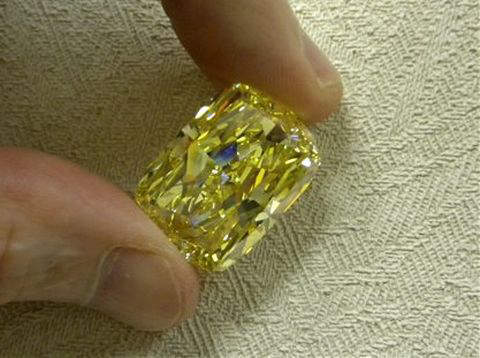
Flawless, Eye-clear, Golden Eye Diamond
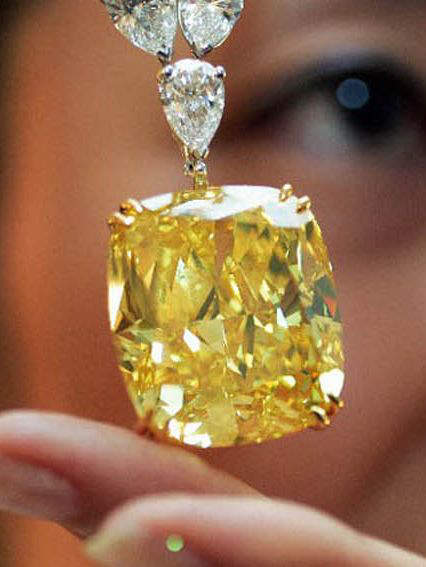
Another image of the Golden Eye Diamond showing its Clarity
The color of the diamond, fancy intense yellow, is two grades short of the maximum color grading fancy vivid, under the GIA's nine-grade color grading system. The Golden Eye diamond is sometimes described as a canary yellow diamond. Canary yellow is not a color grade in the GIA color grading system. It is a loose term used in the diamond trade, and may refer to any of the top four color grades in the GIA color grading system, Viz. Fancy Dark Yellow, Fancy Intense Yellow, Fancy Deep Yellow and Fancy Vivid Yellow. Steinmetz Group, creators of the world's finest diamonds, whose master cutters were involved in the cutting of the "Golden Eye" in its blog webpage on "Rare Diamonds" characterize the "Golden Eye Diamond" as a rare diamond, being the world's largest flawless canary yellow stone.
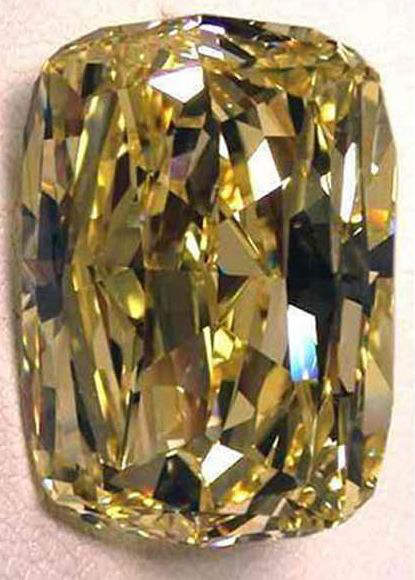
Golden Eye Diamond - Rectangular-shaped modifed brilliant
The cut employed on the diamond is a fancy cut, coming under the category of modified brilliant. Considering the shape of the diamond, we can refer to this cut as a rectangular-shaped modified brilliant or cushion-shaped modified brilliant. The crown of the brilliant cut diamond has 25 facets.
Dimensions of the diamond
The dimensions of the "Golden Eye" diamond are 25.65 X 18.06 X 10.78 mm. In other words the diamond has a length of 25.65 mm, a width of 18.06 mm and a depth or height of of 10.78 mm, equivalent to 1.01 in. X 0.71 in. X 0.42 in.
The Golden Eye Diamond is a rare Type 1b diamond
Being a diamond with a fancy intense yellow color, described by Steinmetz as a canary yellow diamond, the Golden Eye Diamond is undoubtedly a Type 1b diamond, in which the intense yellow color is caused by single nitrogen atoms scattered in the crystal. The nitrogen atoms absorb visible light in the blue region of the spectrum, causing its complementary color yellow to manifest itself. However the occurrence of such intense yellow color diamonds is only 0.1 % of all naturally occurring diamonds. Other famous diamonds which belong to this category are the Alnatt diamond, the Mouna diamond, the Tiffany yellow diamond, the Sarah diamond and the Red Cross diamond.
Type Ia diamonds on the other hand have nitrogen atoms associated as groups of 2, 3, and 4 atoms, known respectively as A-aggregates, N3 centers, and B-aggregates respectively. A and B aggregates having even number of nitrogen atoms do not affect the color of diamonds. But, N3 centers having odd number of nitrogen atoms do affect the color of diamonds. Most of the natural diamonds are Type Ia and Sub-type IaAB, in which A and B aggregates and N3 centers occur together and constitute almost 98% of all naturally occurring diamonds. These diamonds range in color from light to medium yellow
History
The existence of the "Golden Eye" diamond highlighted only after it was seized in November 2006 by the FBI from Ohio Millionaire Paul Monea in a transaction involving money laundering charges
Even though the 124.5-carat "Golden Eye" rough diamond appears to have been cut and polished in New York by the master cutters of Steinmetz Diamond Group, the existence of the "Golden Eye Diamond" was highlighted only in November 2006 when the diamond was seized from its owner, Alliance, Ohio millionaire Paul Monea, in an FBI undercover operation, investigating car dealerships in Stark County suspected of money laundering for South American drug cartels. Monea was unwittingly snared in an FBI sting, when he agreed to sell the "Golden Eye" diamond and Mike Tyson's former Mansion for $19.5 million and a boat, to undercover agent G-Man "Geraldo" posing as a representative of a South American drug kingpin. Monea was arrested and convicted of money laundering and conspiracy to commit money laundering and sent to 13 years in prison in 2007. In the same year the "Golden Eye" diamond was confiscated by a district court judge, and the diamond became the property of the United States Government. Legal claims in respect of ownership or ownership interest in the diamond, at a Federal Court, delayed the acquiring of the diamond by the U.S. Marshals Service, until March 2011, when the Federal judge ordered the final forfeiture of the diamond, which was handed over to the U.S. Marshal's Service, the body responsible for selling ill-gotten gains seized from criminals.
Early History of the Diamond
Early history of the diamond somewhat murky until more details emerged from evidence presented in a Federal Court case that looked into the claims and counter-claims of ownership or ownership interest in the diamond
Except for the fact that the diamond was a Cape-Series diamond that most probably originated in one of the mines in the Kimberley region of the Northern Cape Province of South Africa, during the initial stages of exploration for diamonds in the region after the first diamonds were discovered during the period 1866-1869, nothing was known of the early history of this rare diamond. Tom Moses, a senior vice president with the Gemological Institute of America, agreed that the diamond no doubt came from South Africa, but was not able to say for sure from which mine the diamond originated. Hence, the early history of the diamond was somewhat murky, until more details of the history of the diamond emerged, from uncontested evidence presented at the trial in a Federal Court that looked into the claims and counter-claims of ownership or ownership interest of 17 claimants to the "Golden Eye" diamond.
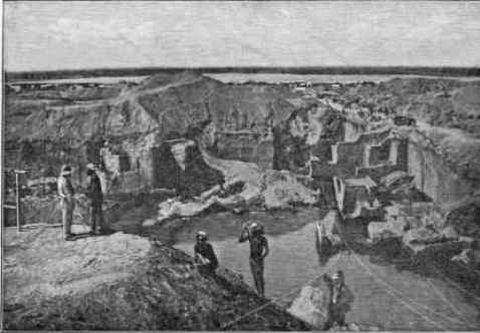
Photograph of Dutoitspan mine taken in 1874
Evidence presented in court that identifies the 124.5-carat "Golden Eye" rough diamond with the long-lost 124-carat "Du Toit II" diamond reported by Edwin Streeter in Chapter XXI of his book "The Great Diamonds of the World."
According to this evidence, the "Golden Eye" rough diamond was 124.5 carats in weight, and was purchased recently from the VanWyke family of Kimberley, Northern Cape Province of South Africa, with whom the diamond had remained as a family heirloom for nearly 150 years. The original owner and discoverer of the diamond was Boer farmer Mr. VanWyke who was a neighbour to Mr. De Beers. The 124.5-carat, "Golden Eye" rough diamond was discovered by Mr. VanWyke in 1871 on his property in Kimberley, South Africa, which subsequently became the Du Toit's Pan mine, the first of the four celebrated Kimberley mines known later as the De Beers Consolidated Mines. The rough diamond that came to be known as the "Du Toit II" diamond was the first African diamond discovered that was over 100 carats in weight. Hence according to this evidence, the 124.5-carat "Golden Eye" rough diamond, is identified with the long-lost, 124-carat, "Du Toit II" diamond, reported by Edwin W. Streeter in Chapter XXI of his book, "The Great Diamonds of the World" published in 1882.
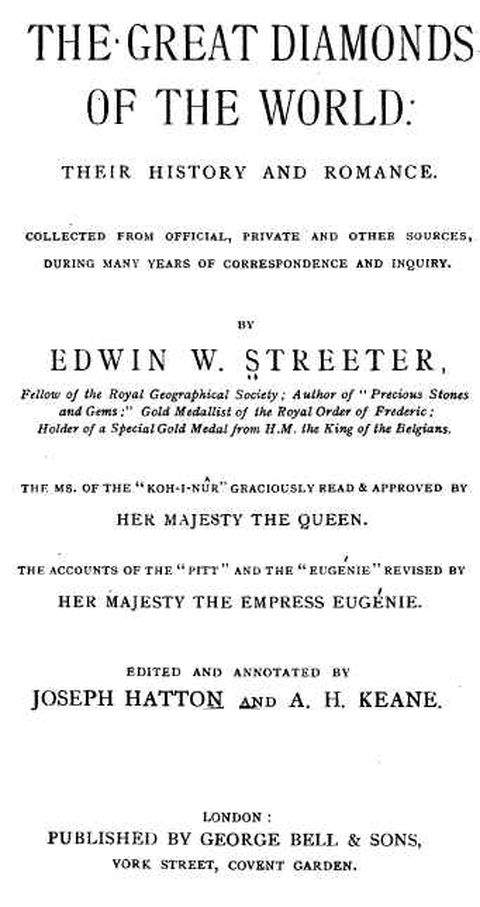
Cover Page of Edwin W. Streeter's book "The Great Diamonds of the World"
What Edwin Streeter says about the "Du Toit II" diamond in Chapter XXI of his book "The Great Diamonds of the World."
Chapter XXI
Du Toit II
THIS stone is named after the "Du Toit's Pan," dry diggings,* in South Africa. The mine belonged to Mr. Van Wyke, and it began to prove attractive to a few diamond hunters for the first time in 1870. It is situated about twenty-four miles from the Vaal river. Within a short time after the first really active operations, some fine stones were discovered, and in 1871, there sprang up quite a lively encampment of diggers. "The Pan" is now worked by several mining companies. The " Du Toit II," was found by Messrs. Stevens and Raath, on July 21, 1871. It weighed in the rough, 124 carats.
 Foot Note at the bottom of page 190
Foot Note at the bottom of page 190

Du Toits Pan Road. Kimberley, South Africa
Apparent contradiction in the accounts of the discovery of the rough diamond according to evidence led in court and Edwin Streeter's account in his 1882 publication
The only contradiction in the accounts of the origin of the rough diamond according to evidence led in the Federal Court and Edwin Streeter's account from his 1882 publication, is that in the former, the 124.5-carat, "Golden Eye" rough diamond was discovered by Mr. VanWyke himself in 1871, whereas in the latter, the 124-carat "Du Toit II" rough diamond, believed to be the same diamond that subsequently came to be known as the "Golden Eye" was discovered by Messrs. Stevens and Raath, on July 21, 1871, after the mine was sold by Mr. VanWyke to the British Company, London & South African Exploration Company, for £2,600. However, in spite of this contradiction it is fairly certain that the 124-carat "Du Toit II" rough diamond and 124.5-carat "Golden Eye" rough diamond refer to one and the same diamond discovered in 1871, in the region that subsequently became the Du Toit's Pan diamond mine.
Modern History of the diamond
How did the "Golden Eye" diamond come into the possession of informercial king Paul Monea ?
Even though the "Golden Eye" diamond was seized from Paul Monea by the FBI, they were not able to establish how the diamond came into his possession, as Monea refused to co-operate with the investigation and give any details about his transactions. However, it was revealed that Monea always carried the diamond in a velvet bag in his pocket, and boasted to friends and acquaintances that he owned a diamond mine in Africa, and that he received the diamond from a friend.
The Federal Court that investigated the ownership and ownership interest claims of 17 claimants, finally ruled that three claimants had seemingly true or genuine ownership claims and granted permission to proceed to civil trial. These claimants are 1) Charity Fellowship Church 2) Jerry deLeo of Corona Clay Corp. and 3) the Monea Family Trust. However, the Monea Family Trust were not able to establish ownership or purchase of the rough stone. On the contrary, Charity Fellowish Church and Jerry deLeo of Corona Clay Corp. were able to show to the court, that they had spent nearly a million dollars to cut and polish the 124.5-carat diamond.
According to evidence led in court, the "Golden Eye" rough diamond was purchased from the VanWyke family either by Jerry deLeo or the Charity Fellowship Church, acting alone or in partnership
Hence, according to the evidence led in court, the "Golden Eye" rough diamond was purchased from the VanWyke family either by Jerry deLeo or the Charity Fellowship Church, acting alone or in partnership with one another, and hence the need to spend a million dollars together, to get the rough diamond cut and polished by master cutters of Stein metz group of New York.
Court findings lead to the conclusion that the "Golden Eye" diamond was never owned by Paul Monea but was perhaps entrusted to him for sale to a suitable buyer, by the owners
Another significant finding by the court, was that although people had ownership claim on the diamond, Monea's conspiracy to sell the diamond existed, even before the diamond came into his possession. This finding coupled with the fact that the Monea Family Trust was not able to establish ownership or purchase of the rough stone, leads one to the conclusion, that the "Golden Eye" diamond was perhaps entrusted to Paul Monea by the owners of the diamond, the Charity Fellowship Church/Jerry deLeo, to be sold to a suitable buyer on their behalf. The owners of the diamond, were perhaps not aware of the shady dealings of Paul Monea, who had planned in advance to sell the diamond and perhaps Mike Tyson's former mansion at a handsome profit to any rich client who had made his riches whether by legal or illegal means.
Court findings that Monea's conspiracy to sell the diamond to a drug kingpin existed even before the diamond came into his possession led to its final forfeiture to the U.S. Government, and authorization being granted to the U.S. Marshals Service for its final disposal by public auction
It was the finding by the court that Monea's conspiracy to sell the diamond existed even before the diamond came into his possession, that led to the final forfeiture of the diamond to the U.S. government, and final approval granted to the U.S. Marshals Service, the body responsible for selling ill-gotten gains seized from criminals, to sell the diamond by public auction.
Extract of a CNN report on the final forfeiture of the "Golden Eye" diamond to the U.S.Government and the diamond being entrusted to the U.S. Marshals Service for sale by public auction
Known for his involvement in the Tae Bo workout craze and a failed effort to market electric grill lighters as pain relievers, Monea was convicted in 2007 of conspiring to sell the diamond and a mansion once owned by former heavyweight boxer Mike Tyson in exchange for $19.5 million and a boat, according to court documents. There is no clear evidence of how Monea came to possess the diamond, according to court documents. He allegedly told others involved in the case that he owned a diamond mine in Africa and that he received the diamond from a friend. The diamond was forfeited to the government by a district court judge in 2007, the Department of Justice said. Legal claims delayed the process until March, 2011, when the final forfeiture was ordered and the U.S. Marshals Service acquired it. The U.S. Marshals Service is responsible for selling seized and forfeited properties acquired by federal criminals through illegal activities, the DOJ said. Proceeds from the auction are used to compensate victims, pay for law enforcement initiatives and support community programs, according to the Department of Justice.
The U.S. Marshals Service decide on an online auction procedure for the "Golden Eye" diamond and entrust the sale to a Silver Spring, Maryland based online auction company known as Bid4Assets
The U.S. Marshals Service decided on an online auction procedure for the "Golden Eye" diamond, the biggest precious stone ever seized by them, and valued by some experts to be worth as much as US$ 20 million. The diamond was kept in a vault in Cleveland until its auction. The online auction was entrusted to an online auction company based in Silver Spring, Maryland, known as Bid4Assets. The company scheduled the online auction for three days beginning from September 6 to September 8, 2011. However, the week before the auction, from August 29 to September 2, the diamond was available for viewing in Cleveland, by prospective customers, who were required to place a refundable deposit of US$ 180,000 for viewing the diamond, as well as placing bid on it subsequently. A diamond grading report issued by the Gemological Institute of America was also made available for prospective bidders.
The online auction of the "Golden Eye" diamond generates worldwide interest with queries from countries such as China, Russia, Israel and Saudi Arabia
According to Jenny Lynch, a spokeswoman for the online auction company Bid4Assets, the "Golden Eye" diamond was the largest and most valuable diamond to be auctioned by the company in its 12-year history. Peter Elliot, U.S. Marshal for the Northern District of Ohio, predicted in a statement issued by him before the auction, that the precious gem was sure to generate interest worldwide. True to his predictions the Marshalls Service in Cleveland, had received calls from potential bidders from all over the United States, as well as from several countries such as Saudi Arabia, China, Israel and Russia.
Sixteen bids were placed online during the three-day auction and the final winning bid of US$ 2.84 million was placed by Ohio home builder, Jerre Hentosh
The online auction was due to start at 8.00 a.m. on Tuesday, September 6, 2011 and close at 3.00 p.m. on Thursday, September 8, 2011. Bidding for the diamond was set to start at US$ 900,000 and was expected to go up by US$ 110,000 increments. Sixteen bids were placed online during the three-day auction, and the final and winning bid of US$ 2.84 million was placed by Ohio home builder, Jerre Hentosh. Commenting on his successful bid, Hentosh is reported to have said that he and his wife had occasionally dabbled in the purchase and sale of fine jewelry, but had never before bought anything so valuable online. He further said that he had been prepared to pay up to US$ 7 million for the diamond.
$1.2 million from the sale of "Golden Eye" diamond distributed among area police departments and other law enforcement agencies that assisted in the investigations
According to the Department of Justice, the U.S. Marshals Service is the body responsible for selling seized and forfeited properties acquired by federal criminals through illegal activities. Proceeds from the auction are used to compensate victims, pay for law enforcement initiatives and support community programs. Accordingly, out of the $2.84 million realized from the auction of the "Golden Eye" diamond by the U.S. Marshals Service, $1.2 million were given out on Wednesday, July 10, 2013, to several area police departments and other law enforcement agencies, that assisted federal authorities in investigating suspected money laundering dealings by auto-sales businesses, in Stark County, Canton, Ohio.
Steven M. Dettelbach, U.S. attorney for Ohio’s northern district, at a news conference held on Wednesday, July 10, 2013, in Canton City Council chambers, said that the Canton police have received $749,525, the largest share of the distribution, while Alliance police got $283,429. Others receiving money from the Monea case were: Stark County Sheriff’s Office, $37,092; Internal Revenue Service and Shaker Heights police, $36,643 each; the Ohio National Counterdrug Task Force, $19,496; Jackson Township police, $12,289; Massillon police, $8,990; and Perry Township police, $3,855.
Dettelbach called the allocations a “double whammy” on criminals because law enforcement is hitting them in the pocketbook and also is pouring money from the seized contraband back into agencies to continue to fight crime.
Canton police Chief Bruce Lawver expressed his gratitude for the cash, saying the funds would be used for technology, equipment and training within the department. He and other speakers said they will continue to participate in such task force collaborations.
“It’s great to be sheriff for only five months and get a check for $37,000,” Stark Sheriff George Maier said. “We’ll take more if you have it.”
Dettelbach made a point to say that the money was “not a windfall but a reward for what they do ... a job well done.”
Federal law, he said, allows assets seized in crimes and criminal investigations to be given back to departments that helped work the case. Federal agencies take the first 20 percent, he said.
Related :-
External Links :-
https://law.justia.com/cases/federal/appellate-courts/ca6/08-3102/10a0279n-06-2011-02-25.html
References :-
1) Golden Eye Diamond - From Wikipedia, the free encyclopedia
2) Rare Diamonds - Steinmetz, Creators of the World's finest diamonds. https://largediamonds.steinmetzdiamonds.com/2011/10/rare-diamonds.html
3) The Golden Eye Diamond - www.diamondland.be/diamondnews/famous-diamonds-golden-eye-diamond
4) The Bizzaro Story of the Flawless 43-Carat "Golden Eye" Diamond and its Upcoming Auction - www.feelguide.com
5) Local police share $1.2 million from sale of "Golden Eye" diamond - George W. Davis - www.green.ohio.com
Powered by Ultra Secure
Amazon (USA) Cloud Network

Founder Internet Stones.COM
Register in our Forums
| Featured In
|
|
|
|
|
|
|
|


















